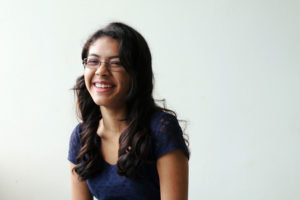
by Maya Rios, staff reporter
Dancing across the screen, an ordinary girl catches the eye of the handsome prince. Her blue ball gown glistens on her fair skin and matches her eyes. As I stare at the screen, I see the exact definition of beauty.
Bright blue eyes.
Blonde, thin hair.
Fair white skin.
The movie’s over. I walk to the bathroom and look in the mirror.
Dark brown eyes.
Brown, thick hair.
Brown skin.
I knew I wasn’t beautiful. I knew that I didn’t have the beauty of Cinderella or Snow White. As far as I knew, there wasn’t a princess or heroine of my nationality or looks in a Disney movie. As far as I knew, I wasn’t the media’s definition of beauty. I was a five-year-old girl who didn’t believe she was beautiful.
I grew up thinking beauty was found in the pretty white girls in every Disney and Barbie movie. My mother raised me in white society, unknowingly teaching me that a Hispanic girl’s looks weren’t good enough for society’s beauty standards. I would turn off the light and look at the silhouette in the mirror and think, “Wow, she’s beautiful,” and I would pretend that the girl in the mirror was a Disney princess, fair and beautiful. But when I turned on the light, all I saw was me.
From then on, I began to dislike the color of my skin. It stood out in my group of white friends, for one thing. Another was when I noticed that most of the models in the displays had fair skin. And once I tried on the clothes, I felt like it didn’t look the same, so I put them back on the rack. The models mocked my colored skin, because everything seemed tailored for their fair skin.
When I was old enough to change how I looked, I found, in the last little corner of the last aisle, a small but pretty section of makeup that was marked in special golden boxes. Above the display was a picture of a smiling lady with colored skin, wild curly hair, and dark brown eyes. When I looked at her I noticed her smile went all the way up to her eyes. It made me wonder, “Does she think she’s beautiful, or does she feel beautiful?”
Does she think she’s beautiful, or does she feel beautiful?
Rephrase.
Do I not think I’m beautiful, or do I not feel beautiful?
Going back to ten years ago, looking at the silhouette in the mirror. I felt beautiful. The light illuminated my frowning face in the mirror. I didn’t feel beautiful. With this memory, a new philosophy came to mind: Being beautiful should be defined by the way a girl (or boy) feels, not by what the princess (or prince) in the Disney movies looks like. Every girl is different, but every girl deserves to know they’re beautiful because of the way they feel, rather than waiting for a fairytale prince to say, “You’re beautiful.”
I won’t say that I’ve suddenly found myself beautiful despite ten years of disliking how I looked. I can say that I’m learning to find the little things I find beautiful in myself, whether it’s a good hair-day or when I master a makeup look, the little things that make each of us uniquely beautiful.
There are times when I look in the mirror and only see the five-year-old girl who thought Hispanic girls weren’t beautiful in her society. I won’t say I’m beautiful, and I don’t allow any of my friends to call me pretty or cute because I believe that’s for me to decide. And I hope that every girl, from kindergarteners watching Disney to college girls waiting for their prince to call them beautiful, decides for themselves what makes them beautiful.
There are so many girls who think they’re not beautiful for different reasons. Whether it be their weight or height or even their personality– but I want them to realize something: that they can never be truly beautiful if they don’t realize that they have their own unique traits that make them beautiful, but there will be those lazy days when beauty isn’t all that important. To simplify, I like to say “Beautiful is an emotion, not an adjective used to describe a woman’s worth.”

